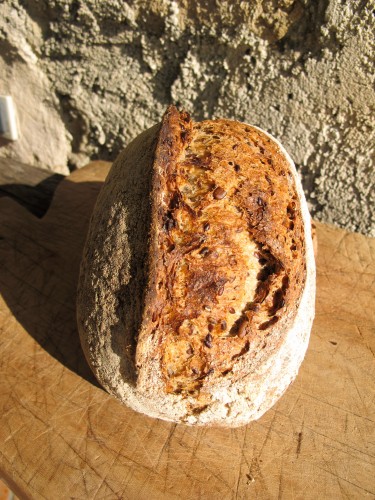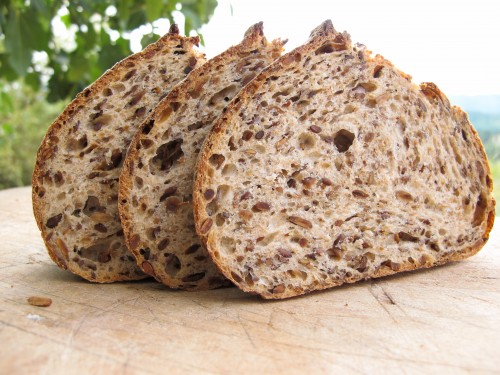Pain au Levain aux grains mélangés
When I was living in Philadelphia, making bread on the weekends was something that punctuated a long work week; it was a time to relax, get my mind off design projects, get away from the computer screen and feed my neighbors fresh bread. If the bread turned out to be a disaster, which wasn’t very often, I could walk to the local bakery and buy a nice sourdough loaf. Now that I reside in the mountains in southern France, landlocked without a car, my attitude has changed drastically. My weekend loafing has become an essential staple of daily subsistence and not to be taken lightly, a failed bake could mean no bread for meals…a real disaster! Yes… it is true…big part of my now simple life now revolves around what bread is on the cutting board wrapped in linen. After having success making Pain au Levain from Daniel Leader’s Local Breads a few times, I wanted to see if I could change it up to give it a better shelf life and added flavor. I looked in the pantry and found that I had a whole lot of whole-wheat flour, sunflower, sesame and flax-seeds ready to be used. My mouth started to water when I started thinking about the nutty flavors of the toasted seeds and whole-wheat flour….a perfect marriage for tangy, mellow goat cheese and some hearty cured sausage….lunch. This Pain au Levain is a real winner! It is a dense bread but not heavy, you can really taste the nutty flavors of the toasted seeds and the soaked flax which makes it very moist bread and extends its shelf life… if it doesn’t get eaten right away.
Pain au Levain with sunflower, sesame and flax seeds
Loosely adapted from Daniel Leader’s Local Breads
Desired dough temperature 76°
Levain Starter:
- (Note, use only 125g, refresh remaining levain and store for next bake)
- 45 g stiff Levain starter
- 95 g Type 65-style flour or all-purpose unbleached flour
- 5 g stone-ground whole wheat flour
- 50 g water
Ingrédients:
- 235 g Type 65 style flour (extraction rate 78-82%)
- 185 g Type 110 stone-ground whole wheat flour (extraction rate 85-90%)
- 30 g Type 150 rye flour
- 30 g gluten du blé (optional, I used it because of seeds)
- 235 g water
- 125 g stiff Levain
- 10 g salt and
- 110 g sunflower seeds, toasted (see below)
- 60 g sesame seeds, toasted (see below)
- 327g soaker (see below use all)
Soaker:
- 100 g flax seeds
- 227 g water
Bread method:
- The night before take your levain out of the refrigerator, weigh out the appropriate amount of starter and mash the levain with a whisk in a bowl with the water. Add the flours and stir with a spatula until it comes together. Turned out onto the work surface and knead to incorporate the flours. Place the Levain in a covered container and let it sit at room temperature (76°) for 8-12 hours or until it has doubled in volume and the surface is domed. After you prepare the Levain place the flax seed in a bowl with the water and tightly cover. The flax-seeds will absorb all the water and become a gelatinous, slippery gel. To toast the seeds, place on a baking tray in a preheated oven at 380 deg. for 6-8 minutes or until nicely browned. (I like them really dark; it gives a remarkably nutty taste.) Stir occasionally for even toasting. Note: Make sure to use the appropriate amount of Levain called for in the recipe…the remaining amount can be refreshed and stored in frig for future use.
- Pour the water into a large mixing bowl or the bowl stand mixer. Combine the all of soaker (flax seeds), flour, whole-wheat flour, rye flour and water until all the ingredients are incorporated. Cover and let it rest for 20 minutes, while the flour hydrates and the gluten begins to develop. (I could not fit my Kitchen Aid Pro in my suitcase, so I mix by hand… I autolyse/rest for one hour before adding the Levain, which really helps the gluten development)
- Kneading By hand: Turn the dough out onto your work surface. I flatten the dough into a large rectangle; smear the Levain on top of the dough. With floured or oiled hands knead a few strokes to fully incorporate the starter, flatten out the dough again and evenly disperse the salt and continue kneading for 12 to 15 minutes. I use a combination of the French kneading technique and this method if the dough is really wet to start. For the first couple of minutes it will be a sticky mess on your work surface, but do not yield to the temptation of adding more flour. Stop occasionally and use your bench scraper to gather any stray dough off of your work surface and ceiling. At this time add the toasted seeds. I tend to add them at the end of mixing to prevent the sharp grains from ripping the gluten structure. Continue until you have a good gluten development. You should be able to gently stretch a piece of the dough into a thin membrane that you can almost see through without it tearing. By machine: Add the salt and Levain and mix the medium speed until the dough cleans up the bowl and you reach a good gluten development. Add seeds on low speed the last minute or so.
- Transfer of the dough to a lightly oiled container. Cover and let it ferment at room temperature for one hour (76°). If you would like to get a good overall picture of the bread making process for the home baker, I highly recommend you check out Mark’s videos at the Back Home Bakery
- Turn the dough out onto your lightly floured work surface, fold the dough and return it to oiled bowl with folds on the bottom and cover. Let the dough ferment for 2 to 3 hours more. You can incorporate another fold after 50 minutes if you’re dough does not seem to have strength.
- Divide into two equal pieces and lightly pre-shape into a boule or a log shape. Lightly flour the dough, cover and let rest for 10-15 minutes.
- Shape each piece of dough into a batard about 12 inches long and place seam side up on a floured couche or into floured bannetons. Cover with a plastic bag or plastic wrap and proof at room temperature for 1-1 1/2 hours. (76°)You can retard the shaped loaves overnight 8-12 hours if desired and bake the next day.
- About one hour before baking, preheat the oven to 500°with baking stone and a tray in the bottom of the oven for steam. I like to add one cup of water or a hand full of ice cubes to the bottom tray a few minutes before putting the loaves in the oven to produce a moist environment for the baking of the proofed loaves.
- Gently turn the proofed loaves onto parchment paper or your floured peel. Score the loaves. Slide the loaves onto the baking stone, turn down the oven to 400° and continue to bake for 20 to 25 minutes. (I turn the oven down to 460° and then after 20 minutes, rotate them to get an even distribution of the heat.)
- Let cool on a wire rack before digging in.








